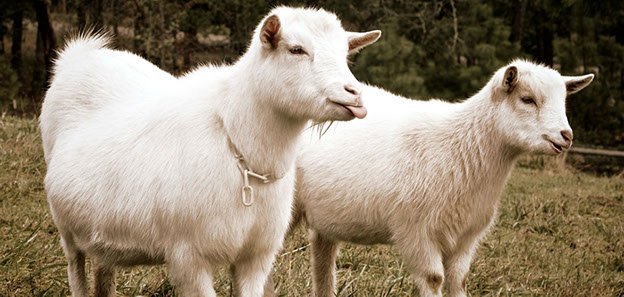Goats are most commonly found on farms however they are becoming increasingly popular as pets. Like any other pet, a goat is a big commitment and the decision to keep a goat as a pet should not be taken lightly or rushed in to.
For the most part goats make good pets. They are easy to handle, curious, friendly and make great companions. There are many breeds available and nearly any breed can be raised as a pet or companion.
Most people prefer smaller breeds such as dwarf or pygmy goats. As well, female goats and castrated male goats (also known as wethers) are preferred to intact males. This is because intact males tend to get larger and will be more aggressive. It should also be noted that male goats will have an offensive odor during the fall (mating season).
All goats are born with horns. Disbudded goats often make better pets than those that have horns. This is because animals with horns can get their heads stuck in fences and other areas and may use their horns as weapons against other animals or people. As well, it is best to choose a breed that does not require shearing.
Goats are herd animals and should not be kept as solitary pets. If possible a pair of goats should be kept.
A sufficient amount of space is required in order to keep your goat happy and healthy. The amount of space you require depends on the breed of goat you have as well as the number of goats.
It is important that you check local laws and bylaws to make sure that you are legally allowed to keep a goat as your pet, as many places do have restrictions on agricultural species.
Goats are prone to a number of infectious and chronic diseases so be sure you are able to provide your goat with necessary health care.
The most common health issue with goats involves parasites and worms. While goats can have some worms in their system, if there are too many they can become very sick and even die. It is important that vaccinations and other treatments for this issue are utilized. Young animals are most at risk and often need to be de-wormed one or more times before the age of one. Older goats build immunity to these parasites and may need little or no treatment. Although it is not registered by the Food and Drug Administration for use as a de-worming product, farmers often find that food grade diatomaceous earth works well for de-worming their goats. Goats should also be vaccinated each year for clostridial diseases including overeating disease and tetanus.
If your goat does become sick he or she will often keep to themselves and may stop eating. They may hang their head and have droopy ears and a droopy tail. You will be able to tell if your goat is in pain if he or she begins grinding their teeth. As well, you can check their temperature. A goat’s body temperature should be 102-103 degrees farenheit, with anything above this indicating a fever or infection.
**Please note: in the case that you encounter any medical problem with your pet goat, a veterinarian should be consulted for proper treatment.
Before purchasing a goat from a breeder, be sure that they follow good practices in terms of preventative medicine and proper treatment, care and conditions.
Once you have made the decision to keep a goat as a pet it is important to note that goats are known for their escape artist abilities. It is therefore important to make sure that you have a secure outside area or yard where your goat can roam. As much as your goat needs to be kept in, a secure area is important in order to keep predators out. Goats can be vulnerable to attacks by other animals such as dogs and coyotes, especially when tethered.
Your goat will need exercise. A yard of approximately 50 square feet is recommended however it is possible to provide your goat with the exercise it needs by taking him or her for a walk, to a park, etc.
You will also need to trim your goat’s hooves. This may need to be done every few months or as little as once a year depending on your goat. It is important to trim the hooves in order to prevent hoof problems and to allow your goat to walk normally. In order to do this you will need to purchase a proper pair of hoof or foot paring shears.
Proceed to trim your goat’s hooves while he or she is standing. Simply lift up the foot and trim the hoof back until you see that it is starting to look pink. This pink color is an indication that you are getting close to the blood supply. Once complete, the nail, sole and heel should be parallel with the growth bands that are around the outside of the hoof.
As for food, a goat will eat grass, but prefers to eat woody plants, shrubs, trees, and leaves as well as plants that you may not want them to eat.
Mature goats that do not have babies and are not pregnant require approximately 2 percent of their body weight in feed. For example, if your goat weighs 150 lbs it will require 3 pounds of feed per day. Young goats will have higher nutritional requirements.
It is recommended that you do not feed your goat too much grain, as this can lead to many health problems. As part of their diet, your goat should also be given a mineral that is formulated for them. Please consult your local feed or pet store for the proper feed for your goat.
Always provide your goat with access to fresh, clean water. If they do not drink a lot of water this most likely means that they are getting sufficient moisture from their feed.
It is important to keep your goat from becoming too fat. This is often hard to do with pet goats because it is difficult to have them on a hay or pasture diet.
As long as you are familiar with and prepared for the commitment that it takes to raise a goat, you will find that they are fun, enjoyable and rewarding pets.
Image by Brendon Burton


